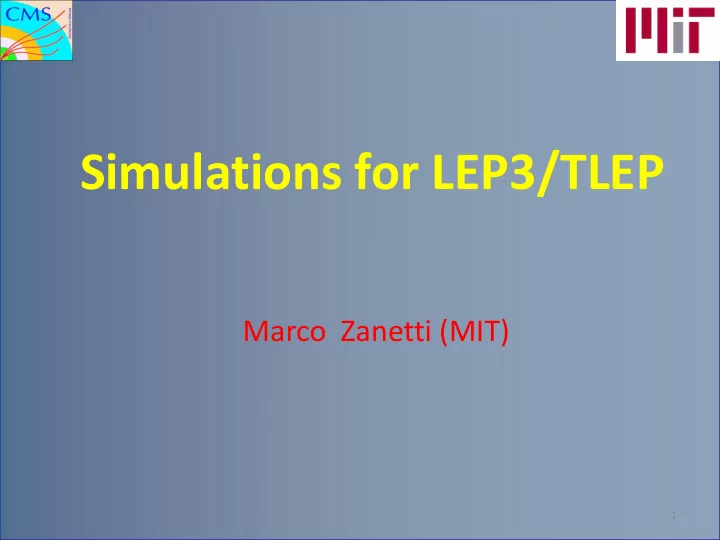

Simulations for LEP3/TLEP Marco Zanetti (MIT) 1
Introduction • Beams are squeezed at the IP to push for high luminosity. • Similar to ILC but in this case beams cannot be disrupted after the collision. • Beamstrahlung effects must be mild enough to allow a reasonable lifetime – At least larger than burn-out lifetime • Additional key ingredient is the enhanced momentum acceptance – we aim at 4% (by increasing RF voltage) • LEP3/TLEP parameters already chosen accordingly to analytical formulation and full beam-beam simulation – V. Telnov, http://arxiv.org/abs/1203.6563, based on analytic formulation of the problem – MZ at 1 st LEP3 workshop, http://tinyurl.com/8lzdad2 2
Simulation – Analytic form • Analytic functional form (red in the plot): • Constants not checked yet 3
Outlook • BS lifetime results (TLEP) • Luminosity profile • Power dissipation • Multi-turn simulation 4
Energy spectrum • Single crossing guinea-pig based simulation – Simulate 360M macroparticles around the working point • Lifetime features exponential dependency on energy acceptance TLEP-T TLEP-H Lifetime>4h h =3% • As for LEP3, TLEP BS lifetime well above required threshold • In particular some margin (x2 ?) is there for TLEP-H 5
Luminosity profile • Look at the how much luminosity is delivered within 1% of nominal √s (L 0.01 ) – Key quantities for Physics – ISR not included, single crossing simulation • Beamstrahlung effects much smaller than at ILC • Almost monochromatic luminosity profile – Very similar performances for all circular collider options • To be confirmed by multi-turn simulation 6
Power dissipation • The photon flux could be problematic for machine and detector instrumentation • Run the simulation to estimate the photon rate and energy • Use that to compute how much power is dissipated as a function of the polar angle LEP3 7
Power dissipation • Similar dissipation for LEP3 and TLEP (O(10) kW integrated) • Should be manageable, most of the power dissipated at very small angle – No harm to experiments – Beam pipe needs protection – Flux on quadrupoles rather limited TLEP 8
Multi-turn simulation • Goal is to check the beam parameters at equilibrium – Assume TLEP-H parameters • Integrate beam-beam simulation with simple longitudinal and transverse dynamics • Transverse motion: – Qx,Qy>0.5 • Synchrotron motion: • Radiation damping: 9
H plane: effect of collision • A correlation is introduced – Linear in the bulk, non-linear in the tails • Correct it by means of a rotation matrix (quad): – a determined empirically from the fit of the bulk 10
H plane: effect of correlation Colliding once and then transporting the beams around w/o further collision (divergent otherwise) 11
H plane: compensating correlation • Collide only once, then transport • Correct right after the collision • Rotation of the tails not fully corrected 12
H plane: full simulation • Collide at every turn in 1 IP • Still some beating 13
V plan: full simulation • Small correlation also here • No compensation applied, still beam is not diverging 14
Z plane: full simulation • Strong damping • Not totally clear to me.. 15
Summary • Analytic computation verified by simulation – Very short lifetime for original beam parameters – Negligible effect on energy spread – Number of gammas <1 (0.6) • First implementation of multi-pass simulation is encouraging – Need to cope with large a in the H plane • Long to do list: – Understand/debug features – Compute relevant quantities at equilibrium – Implement 4 IPs – .. 16
17
18
Recommend
More recommend